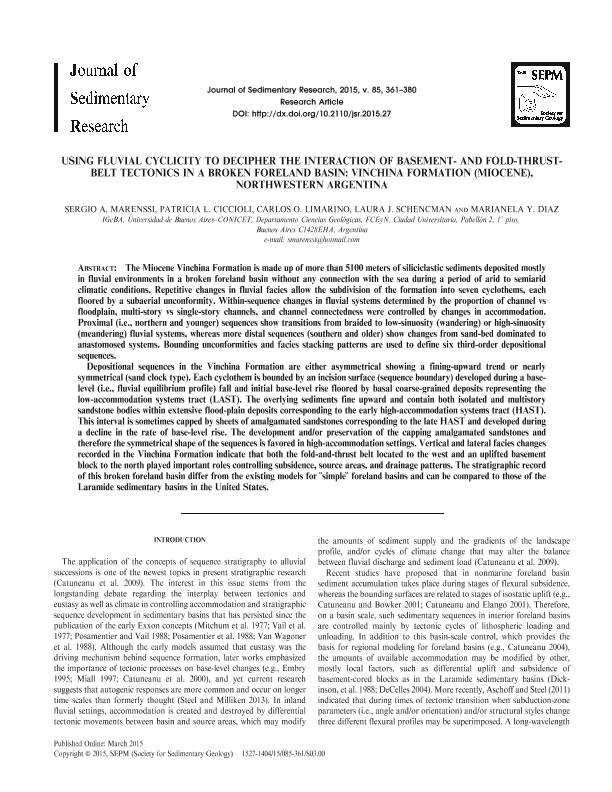Mostrar el registro sencillo del ítem
dc.contributor.author
Marenssi, Sergio Alfredo

dc.contributor.author
Ciccioli, Patricia Lucia

dc.contributor.author
Limarino, Carlos Oscar

dc.contributor.author
Schencman, Laura Jazmín

dc.contributor.author
Díaz, Marianela Ximena Yasmin

dc.date.available
2017-12-04T19:49:07Z
dc.date.issued
2015-04
dc.identifier.citation
Marenssi, Sergio Alfredo; Ciccioli, Patricia Lucia; Limarino, Carlos Oscar; Schencman, Laura Jazmín; Díaz, Marianela Ximena Yasmin; Using Fluvial Cyclicity To Decipher the Interaction of Basement- and Fold-Thrust-Belt Tectonics In A Broken Foreland Basin: Vinchina Formation (Miocene), Northwestern Argentina; Society for Sedimentary Geology; Journal Of Sedimentary Research; 85; 4; 4-2015; 361-380
dc.identifier.issn
1073-130X
dc.identifier.uri
http://hdl.handle.net/11336/29617
dc.description.abstract
The Miocene Vinchina Formation is made up of more than 5100 meters of siliciclastic sediments deposited mostly in fluvial environments in a broken foreland basin without any connection with the sea during a period of arid to semiarid climatic conditions. Repetitive changes in fluvial facies allow the subdivision of the formation into seven cyclothems, each floored by a subaerial unconformity. Within-sequence changes in fluvial systems determined by the proportion of channel vs floodplain, multi-story vs single-story channels, and channel connectedness were controlled by changes in accommodation. Proximal (i.e., northern and younger) sequences show transitions from braided to low-sinuosity (wandering) or high-sinuosity (meandering) fluvial systems, whereas more distal sequences (southern and older) show changes from sand-bed dominated to anastomosed systems. Bounding unconformities and facies stacking patterns are used to define six third-order depositional sequences. Depositional sequences in the Vinchina Formation are either asymmetrical showing a fining-upward trend or nearly symmetrical (sand clock type). Each cyclothem is bounded by an incision surface (sequence boundary) developed during a base-level (i.e., fluvial equilibrium profile) fall and initial base-level rise floored by basal coarse-grained deposits representing the low-accommodation systems tract (LAST). The overlying sediments fine upward and contain both isolated and multistory sandstone bodies within extensive flood-plain deposits corresponding to the early high-accommodation systems tract (HAST). This interval is sometimes capped by sheets of amalgamated sandstones corresponding to the late HAST and developed during a decline in the rate of base-level rise. The development and/or preservation of the capping amalgamated sandstones and therefore the symmetrical shape of the sequences is favored in high-accommodation settings. Vertical and lateral facies changes recorded in the Vinchina Formation indicate that both the fold-and-thrust belt located to the west and an uplifted basement block to the north played important roles controlling subsidence, source areas, and drainage patterns. The stratigraphic record of this broken foreland basin differ from the existing models for ¨simple ¨ foreland basins and can be compared to those of the Laramide sedimentary basins in the United States.
dc.format
application/pdf
dc.language.iso
eng
dc.publisher
Society for Sedimentary Geology

dc.rights
info:eu-repo/semantics/openAccess
dc.rights.uri
https://creativecommons.org/licenses/by-nc-sa/2.5/ar/
dc.subject
Fluvial Sequences
dc.subject
Broken Foreland Basin
dc.subject
Vinchina Formation
dc.subject
Miocene
dc.subject.classification
Meteorología y Ciencias Atmosféricas

dc.subject.classification
Ciencias de la Tierra y relacionadas con el Medio Ambiente

dc.subject.classification
CIENCIAS NATURALES Y EXACTAS

dc.title
Using Fluvial Cyclicity To Decipher the Interaction of Basement- and Fold-Thrust-Belt Tectonics In A Broken Foreland Basin: Vinchina Formation (Miocene), Northwestern Argentina
dc.type
info:eu-repo/semantics/article
dc.type
info:ar-repo/semantics/artículo
dc.type
info:eu-repo/semantics/publishedVersion
dc.date.updated
2017-07-10T16:21:29Z
dc.journal.volume
85
dc.journal.number
4
dc.journal.pagination
361-380
dc.journal.pais
Estados Unidos

dc.description.fil
Fil: Marenssi, Sergio Alfredo. Consejo Nacional de Investigaciones Científicas y Técnicas. Oficina de Coordinación Administrativa Ciudad Universitaria. Instituto de Geociencias Basicas, Aplicadas y Ambientales de Buenos Aires. Universidad de Buenos Aires. Facultad de Ciencias Exactas y Naturales. Instituto de Geociencias Basicas, Aplicadas y Ambientales de Buenos Aires; Argentina
dc.description.fil
Fil: Ciccioli, Patricia Lucia. Consejo Nacional de Investigaciones Científicas y Técnicas. Oficina de Coordinación Administrativa Ciudad Universitaria. Instituto de Geociencias Basicas, Aplicadas y Ambientales de Buenos Aires. Universidad de Buenos Aires. Facultad de Ciencias Exactas y Naturales. Instituto de Geociencias Basicas, Aplicadas y Ambientales de Buenos Aires; Argentina
dc.description.fil
Fil: Limarino, Carlos Oscar. Consejo Nacional de Investigaciones Científicas y Técnicas. Oficina de Coordinación Administrativa Ciudad Universitaria. Instituto de Geociencias Basicas, Aplicadas y Ambientales de Buenos Aires. Universidad de Buenos Aires. Facultad de Ciencias Exactas y Naturales. Instituto de Geociencias Basicas, Aplicadas y Ambientales de Buenos Aires; Argentina
dc.description.fil
Fil: Schencman, Laura Jazmín. Consejo Nacional de Investigaciones Científicas y Técnicas. Oficina de Coordinación Administrativa Ciudad Universitaria. Instituto de Geociencias Basicas, Aplicadas y Ambientales de Buenos Aires. Universidad de Buenos Aires. Facultad de Ciencias Exactas y Naturales. Instituto de Geociencias Basicas, Aplicadas y Ambientales de Buenos Aires; Argentina
dc.description.fil
Fil: Díaz, Marianela Ximena Yasmin. Consejo Nacional de Investigaciones Científicas y Técnicas. Oficina de Coordinación Administrativa Ciudad Universitaria. Instituto de Geociencias Basicas, Aplicadas y Ambientales de Buenos Aires. Universidad de Buenos Aires. Facultad de Ciencias Exactas y Naturales. Instituto de Geociencias Basicas, Aplicadas y Ambientales de Buenos Aires; Argentina
dc.journal.title
Journal Of Sedimentary Research

dc.relation.alternativeid
info:eu-repo/semantics/altIdentifier/doi/http://dx.doi.org/10.2110/jsr.2015.27
dc.relation.alternativeid
info:eu-repo/semantics/altIdentifier/url/https://pubs.geoscienceworld.org/sepm/jsedres/article-abstract/85/4/361/145472/using-fluvial-cyclicity-to-decipher-the?redirectedFrom=fulltext
Archivos asociados
